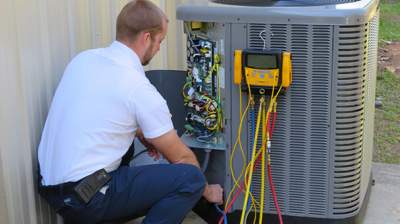WHY HVAC MAINTENANCE KEEPS YOU COOLER LONGER


Most homeowners rarely see their air conditioner. Unlike a refrigerator or washer, people don’t touch their AC every day—half of the system is hidden by bushes outside, and out of sight, out of mind.
Yet in many places in the U.S., air conditioning is vital to making a home liveable. Despite the importance of AC, many homeowners neglect it, doing nothing as problems gradually develop, problems that may only become evident when it’s too late. Routine maintenance can catch these problems early, and homeowners can avoid the headache of repairs, staying cool and saving money.
Just like a car needs an oil change, an air conditioning system needs to be checked and maintained, which is probably why many technicians refer to a preventative maintenance visit as a tuneup. The goal of a tuneup is keeping your system running as smoothly as possible. During one of these visits, a technician examines the performance and condition of the system, inspecting between 15 and 30 components of the system and adjusting where necessary to keep the system functioning at peak efficiency. Technicians usually service both the outdoor condenser unit and the interior unit, carrying out a series of tasks:
The best time to have technicians do maintenance is in early spring, right when homeowners switch their unit from heating to cooling. This way, you receive the benefits of maintenance for longer, and you can save money, too, as many technicians offer discounts on maintenance during the spring. You can still have maintenance done in summer, but it could be more expensive and might take longer to schedule since it’s the busy season for air conditioning repairs.
Average prices for a tuneup in the US range from $60 to $100, and in the spring many technicians offer coupons or publish discounted pricing on their websites. Many HVAC technicians also offer maintenance plans that include a fall maintenance visit focused on your system’s heating performance. By spending a little upfront, though, you can save money and avoid headaches down the line.
Average prices for a tuneup in the US range from $60 to $100, and in the spring many technicians offer coupons or publish discounted pricing on their websites. Many HVAC technicians also offer maintenance plans that include a fall maintenance visit focused on your system’s heating performance. By spending a little upfront, though, you can save money and avoid headaches down the line.
Have you ever had an air conditioner that just couldn’t get it as cool as you wanted? While you may have thought that you needed to replace your system, you may have simply needed maintenance.
Here’s an example of how a tuneup can help: the same particle build-up that decreases the unit’s efficiency also decreases your system’s cooling ability. Your air conditioner cools the air moving through your home by sucking in warm air and passing it over a number of coils filled with refrigerant. The refrigerant absorbs heat from the air that flows over the coils, and the cooled air is then spread by ducts throughout your home.
The dust and dirt reduce the effectivity of the heat exchange process by preventing air from coming in direct contact with the surface of the coils, meaning that you might have to turn the thermostat down really low just to keep your home at a comfortable temperature.
Technicians carefully clean the delicate coils and also monitor refrigerant levels, ensuring that your system has the cooling power it needs.
If an air conditioner is like a car with regards to maintenance, then maintenance is vital. Without regular oil changes, a car gradually develops problems that lead to a major breakdown, shortening the car’s lifespan. The same car, properly maintained, might have driven another 100,000 miles.
By preventing larger problems, a tuneup will keep your system operational longer. Sansone, an award-winning HVAC company based in Florida, states that ”Homeowners who perform regular maintenance can expect their air conditioning systems to last upwards of 25 years—potentially 15 years more than no maintenance.” Manufacturers and technicians alike stress the importance of maintenance in prolonging your system’s life, and most manufacturers require maintenance as part of their warranty. For the same reason, home warranty companies also require maintenance if they offer HVAC coverage, and will require maintenance records to be presented in the event of a claim.
If you’ve decided to have your unit maintained, you just need to contact an HVAC technician (see Cost section above for tips on price), and there are also a couple of things you can do yourself to keep your system humming.
The easiest task is to change or clean the filters in your indoor unit. Technicians will do this during maintenance, but you probably should do it more often. Home size, pets, filter type, and system usage all affect how often you should change the filter–to find more information contact your manufacturer or an HVAC technician. Home Depot also offers some guidance on the subject.
Homeowners should also clear the area around their outdoor unit of plant growth and debris, keeping at least two feet around the unit free of obstruction. This ensures airflow to and from the unit and minimizes build-up and damage to the fan.
SOURCES:
THE NEST: HOW MUCH WILL IT COST ME TO RUN AN AIR CONDITIONER?
HOME DEPOT: HOW OFTEN YOU SHOULD CHANGE YOUR AIR FILTER
PICKHVAC.COM: HVAC WARRANTY GUIDE
AIR CONDITIONING CONTRACTORS OF AMERICA: QUALITY MAINTENANCE OF RESIDENTIAL HVAC SYSTEMS
REALTOR.COM: HOW MUCH DOES AIR CONDITIONING COST?
SANSONE AC: AVERAGE AIR CONDITIONER LIFESPAN
ANGIE’S LIST: HOW OFTEN DOES AN AIR CONDITIONER NEED SERVICE?

Coverage not available in CA, WA and HI